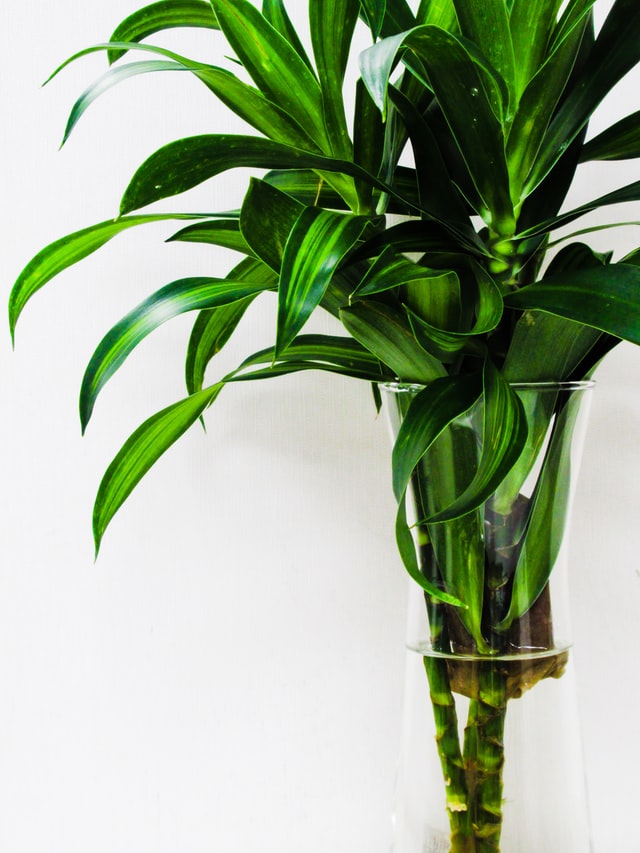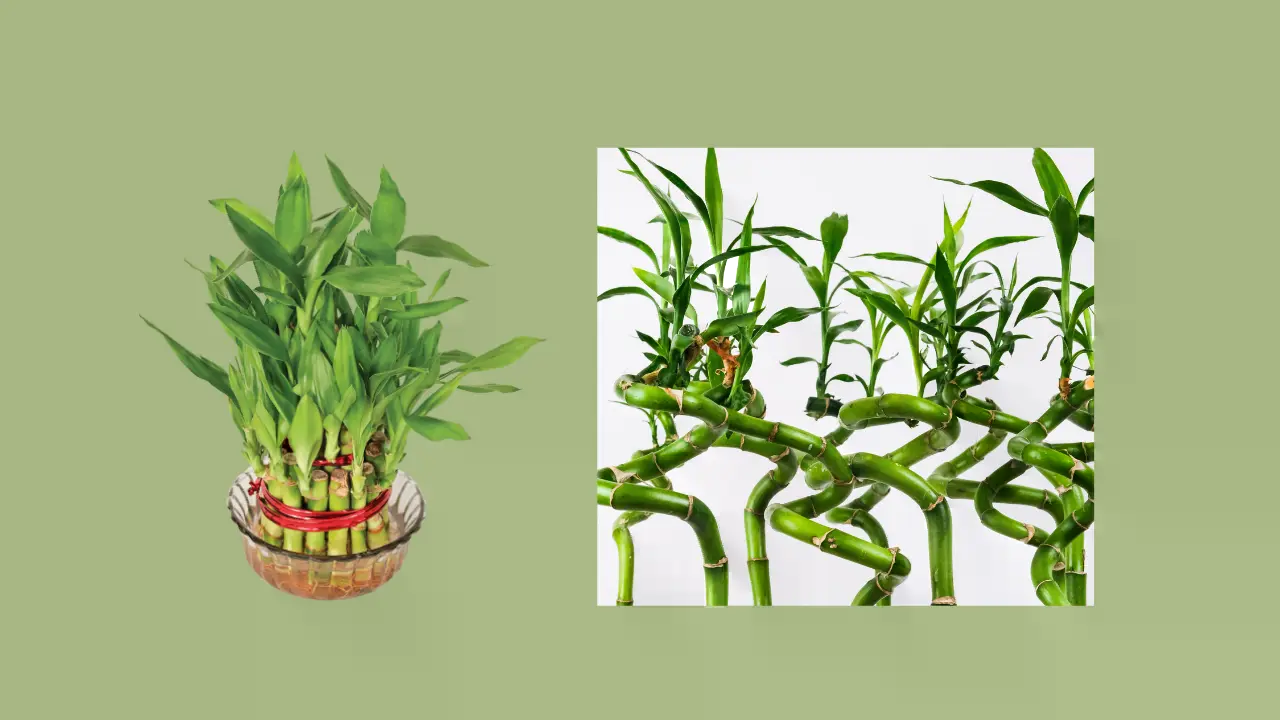There are many different types of lucky bamboo, but the most common and popular type is called Dracaena sanderiana. Some other types are Dracaena marginata, Dracaena fragrans, and Dracaena indivisa.
The benefits of lucky bamboo plants are that they
- Purify air, promote calmness and harmony, and bring good fortune to those who have them in their homes or offices.
- But there are some common problems that often arise with these plants such as not enough light or water or soil that is too dry. There are also tips on how to care for your lucky bamboo plant so you can avoid these

Table of Contents
Uniqueness of Lucky Bamboo
- Despite its resemblance to bamboo, lucky bamboo (Dracaena sanderiana ) is more closely related to succulents than anything else. Common Bamboo is a type of grass.
- Lucky bamboo is originally from African continent, but is now widely cultivated around the world. It is more popular as a good-luck houseplant.
Plant Specifications:
| Common Name | : Wishing Plant , Lucky bamboo, Feng Shui bamboo, Ribbon plant |
| Botanical Name | : Dracaena sanderiana. AlsoDracaena marginata, Dracaena fragrans |
| Family | : Asparagaceae |
| Fully grown size | : 1-4 feet tall |
| Light | : No direct sunlight ( partial shade) |
| Hardiness Zones | : 10–11 (USDA |
| Country of Origin | : African Continent. Now available in Europe and Asia |
Toxicity : Found to be toxic to animals
Common shapes of
Lucky bamboo : 2 layers, 3 layers and 7 layers
Lucky Bamboo – Tips for growing:
It can be grown either in soil or water.
- Before planting, select a clear and transparent glass pot to check the water levels of the Bamboo plant.
- To ensure stability to the stem of the plant, always use a layer of gravels, granules or pebbles. As the plant grows, the stability will be affected if the base is not held tightly.
- If you are planting it and growing in water, always ensure 2-3 inches of water to sufficiently cover the root.
- The water should be properly oxygenated one, free of chlorine. Chlorine will make the plant turn yellow and eventually die.
- DO NOT let the water stagnate onto the roots. Water logging will make the stem rot in no time.
- Never select a plant with yellow or brown leaves. Pale leaves indicate that the plant is suffering due to some issues.

Lucky Bamboo Care :
Lucky bamboo is not a hard to grow and care type of plant. Following simple care and tips will see that plant’s effective growth even during a short period.
- Keep the plant away from direct sunlight. Light with partial shade is best. However monitor the leaves closely. If they turn pale, it’s an indication that the plant needs more light.
- Avoid using fertilizer to a large extent. However can be added incrementally on a monthly basis. DO NOT overdose as its detrimental to the plant
- It does not tolerate very low temperature. Hence maintain the temperature of the surroundings at 65° to 90°F range ( 18-32 deg C)
- If you are growing lucky bamboo in water, try changing the water at least once a week
- Note that this plant is toxic to pets in the house.. So take care accordingly.
- If the stalks grow continuously longer, they can be chopped off and start a new plant by rooting the stalks in water. But one should take care to keep them in shade till new roots are formed.
- From time immemorial, these plants are believed to bring lots of good luck and fortune to those who own them and especially if they are given as gifts.
- The plant is symbolized by various types of stalks. If they have three, it was believed to bring health and happiness, while eight stalks represent development and prosperity.
Basic Ingredients
Lucky bamboo has a reputation as being nearly indestructible. But any plant, there are certain growing conditions your lucky bamboo needs to be healthy such as
- Light
- Water
- Potting
- Fertilizer
- Temperature
Light
- Do not expose the plant to direct sunlight as it would scorch the leaves. Keep them however in partial shade, bright indirect sunlight.
- If the leaves turn stretched, ensure more light is provided
Soil
- They never tolerate waterlogged soaked soil.
- They thrive when the soil is moist and well drained.
- As already explained , they can be grown in water too, in a glass vase or container with pebbles or stones as the case may be and with 2-3 inches of water to cover the roots till they firm up
Water
- The water should be fairly oxygenated for the lucky bamboo plant. Never use a chlorinated water. Distilled water will do the purpose.
- Chlorine in water will be detrimental to the bamboo plant.
Temperature and Humidity
As already stated , do not expose them to very cold temperature surroundings.
Fertilizer
As such they do not require fertilizer and can be used if found really necessary.
Pruning
- All these plants become very heavy and need to be pruned in course of time to prevent them becoming clumsy.
- In a proper way the sidestalks can be pruned using snipers closer to the main stalk.
- This will help new shoots emerge, and the resulting plant will be bushier.
- To retard and stop new growth, the freshly cut end need to dipped in paraffin or wax.

Common Pests of Lucky Bamboo
Some of the most common bugs that affect lucky bamboo plants are :
- Mealy bugs
- Aphids
- Mites
The bugs can either be plucked out manually or the plant washed with mild soap solution
Lucky Bamboo – Common Problems :
Though an easy to grow variety , lucky bamboo too is not immune to common problems faced with similar plants and issues are plenty
Browning Leaf Tips :
- It’s a clear indication of chlorinated water.
- Ensure distilled water free of chlorine is fed to the plant
Black Roots
- Black roots symbolizes infection. Remove the affected roots immediately.
- Roots should be red or orange in color.
Algae
- Algae grows because of sunlight penetration.
- Only solution is to clean the container periodically
- Opaque container is another alternate solution
Yellow Leaves
- Both excess sunlight as well as fertilizer can cause the leaves turn yellow.
- Move them to a shady area
Mushy Stalks
- If the stalks turn black, they need to be cut and thrown away before the other stalks are affected and the plant dies.
- The total container should be thoroughly cleaned and stones changed if the lucky bamboo plant is grown in water
Lucky Bamboo – Propagation :
- These plants are mostly propagated by using cuttings and making them grow
- With the help of sniper, take one cutting from the main stalk .
- Pot it in a container or glass vase with water without any trace of chlorine.
- Roots are likely to develop within 30 days if conditions are favorable
- Once roots develop, repot it with pebbles or stones for stability as discussed earlier.

FAQ
How easy is the Lucky bamboo to care for?
It is very easy as long as it is grown in good quality water. It’s practically indestructible if the above mentioned simple care tips are followed without fail.
How fast lucky bamboo grows?
They grow pretty fast In case of indoor plants, they grow up to 3 feet and some species grow as high as 5 feet. On an average, lucky bamboo plants grow around 1 ½ feet in 6 months duration if taken care properly.
How long can lucky bamboo live?
The average life span is 1-2 years . The same can be extended few more years if repotted well.
We have tried to cover the various aspects of Lucky Bamboo Plants starting from growing tips to the common problems faced.
Do you have a lucky bamboo plant? Please post your views in the comments!

